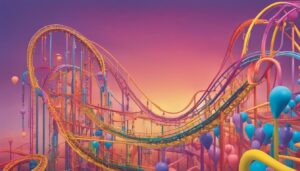Mental illness has been an underlying theme in the lives of many talented painters throughout history. From anxiety and depression to aimlessness and hallucinations, these artists faced a myriad of challenges that deeply impacted their personal lives and artistic expression.
Key Takeaways:
- Vincent van Gogh’s battle with anxiety and depression made a profound impact on his art and relationships.
- Edgar Degas coped with depression and a sense of aimlessness, ultimately creating remarkable Impressionist works.
- Edvard Munch’s anxiety and hallucinations fueled his iconic artwork, including the famous painting “The Scream.”
- Mark Rothko battled depression and excessive drinking, creating emotionally powerful color-field paintings.
- Francisco de Goya endured physical and psychological breakdowns, channeling his struggles into dark and potent artistic creations.
These painters’ stories serve as reminders that creativity can flourish even in the face of adversity. By exploring their personal journeys and examining their artwork, we gain insight into the transformative power of art as a means of coping with mental health struggles.
Vincent van Gogh: A Struggle with Anxiety and Depression
Vincent van Gogh, a name synonymous with artistic brilliance, also harbored a deep-seated struggle with anxiety and depression. Throughout his life, he battled the demons of his mind, wavering between moments of profound creativity and overwhelming despair. Van Gogh’s mental health challenges not only impacted his personal well-being but also left an indelible mark on his art, shaping his distinctive style and emotional depth.
Living with anxiety, van Gogh often found solace in the vibrant and expressive strokes of his paintbrush. His paintings, such as “Starry Night” and “Sunflowers,” reveal his inner turmoil alongside his profound ability to capture raw emotions on canvas. The swirling brushwork and bold colors can be seen as a reflection of his turbulent mental state, an outlet for the chaos that resided within his mind.
Depression weighed heavily on van Gogh, leading to periods of intense sadness and isolation. Despite these challenges, he persisted in his artistic pursuits, finding solace in the creative process. Through painting, he channeled his emotions, seeking refuge in the act of creation and using his art as a means of catharsis.
| Notable Quotes: |
|---|
| “The only time I feel alive is when I’m painting.” |
| “I often think that the night is more alive and more richly colored than the day.” |
H3: The Impact of van Gogh’s Struggles
Van Gogh’s battle with anxiety and depression continues to captivate audiences today, emphasizing the intertwining relationship between mental health and artistic expression. His legacy serves as a reminder that even the darkest moments can give birth to transcendent beauty. His art remains a testament to the power of creativity as a tool for coping and self-discovery, inspiring countless artists who face similar struggles.
Edgar Degas: Coping with Depression and Aimlessness
Edgar Degas, the master of capturing the beauty of movement, fought battles with depression and a constant feeling of being adrift. His struggles with mental health greatly influenced his art and the direction of his life. Despite the challenges he faced, Degas managed to create astounding works that continue to inspire and captivate audiences.
In the depths of his depression, Degas found solace in painting. He would spend countless hours in his studio, meticulously capturing scenes from the ballet, the racetrack, and everyday life. These snapshots of movement became his way of expressing his inner turmoil and finding a sense of purpose in the midst of his aimlessness.
“Art is not what you see, but what you make others see,” Degas once said. And indeed, his paintings were not mere reflections of reality, but rather invitations to delve into the complex emotions that lie beneath the surface. Through his art, Degas was able to confront and examine his own feelings of depression and find a sense of connection with others who may have experienced the same.
| Edgar Degas: Coping with Depression and Aimlessness | |
|---|---|
| The master of capturing the beauty of movement | |
| Battles with depression | X |
| A constant feeling of being adrift | X |
| Solace in painting | |
| Meticulously capturing scenes from ballet, racetrack, and everyday life | |
| Expressing inner turmoil | |
| Aimlessness | X |
| Reflections of reality | |
| Invitations to delve into complex emotions | |
| Connection with others who may have experienced the same |
Edgar Degas’ struggle with depression and aimlessness serves as a reminder that even in the darkest of times, art can be a guiding light. Through his art, Degas not only found personal solace but also created a lasting legacy that continues to resonate with audiences today.
Edvard Munch: Anxiety and Hallucinations as Creative Fuel
Edvard Munch, the visionary behind haunting and emotionally charged paintings, found solace and creative inspiration within the depths of his anxiety and hallucinations. His inner turmoil became the driving force behind his iconic artwork, which continues to captivate audiences to this day.
In the grips of anxiety, Munch’s mind manifested vivid hallucinations that both frightened and fascinated him. He once described his hallucinations as “voices from the depths” that whispered dark truths and conveyed a profound sense of existential anguish.
These experiences fueled Munch’s desire to explore the complex nature of human emotions and to convey his own inner turmoil through his art. His most famous painting, “The Scream,” is a powerful and haunting representation of his anxiety and existential dread.
The Scream: A Symbol of Inner Turmoil
“I was walking along the road with two friends, and then the sun set. Suddenly, the sky turned blood-red. I paused, feeling exhausted, and leaned on the fence. There was blood and tongues of fire above the blue-black fjord and the city. My friends walked on, and I stood there trembling with anxiety – and I sensed an infinite scream passing through nature.”
Munch’s ability to channel his mental health struggles into his artwork serves as a testament to the transformative power of creativity. Through his paintings, he confronted his own demons and offered a raw and honest portrayal of the human condition.
By delving into the lives of painters like Munch who battled mental illness, we gain a deeper understanding of the complexities of the creative process. Their stories remind us that even in the depths of despair, art can provide a lifeline and a means of expressing emotions that may otherwise remain locked within.
| Painter | Mental Health Struggles |
|---|---|
| Vincent van Gogh | Anxiety, Depression |
| Edgar Degas | Depression, Aimlessness |
| Edvard Munch | Anxiety, Hallucinations |
| Mark Rothko | Depression, Excessive Drinking |
| Francisco de Goya | Physical and Psychological Breakdowns |
Mark Rothko: Battling Depression and Excessive Drinking
Mark Rothko, a master of evoking emotions through color, faced his own battles with depression and sought solace in excessive drinking. Despite his inner struggles, Rothko’s artwork remains a testament to his remarkable ability to convey the depths of human emotion.
Depression weighed heavily on Rothko throughout his life, casting a shadow over his creative process. He often used his art as a means of channeling his inner turmoil, resulting in powerful and emotionally charged canvases. With bold strokes and vibrant hues, Rothko’s abstract paintings became windows into his own psyche, inviting viewers to experience the complexity of his emotions.
While depression plagued Rothko, he also turned to excessive drinking as a coping mechanism. Alcohol became a temporary escape from the darkness within, offering a brief respite from his inner demons. However, it is important to note that excessive drinking is never a solution, and seeking professional help is crucial for those struggling with mental health issues.
| Notable Points | Information |
|---|---|
| Artist | Mark Rothko |
| Mental Health Struggles | Depression and excessive drinking |
| Impact on Artwork | Rothko’s art served as an outlet for his inner turmoil, allowing him to express complex emotions through color and form. |
| Emotional Depth | Rothko’s paintings continue to evoke profound emotions in viewers, showcasing the power of art to transcend personal struggles. |
Mark Rothko’s art serves as a testament to the resilience and creativity that can arise from personal struggles. Through his battle with depression and excessive drinking, he channeled his pain into captivating visual experiences. His use of color and form created an emotional language that resonates with audiences to this day.
Francisco de Goya: Illness and Psychological Breakdowns
Francisco de Goya, a master of dark and enigmatic paintings, grappled with physical and psychological breakdowns that deeply impacted his artistic output. Throughout his life, Goya faced various health ailments that profoundly shaped his work.
One of the most notable health challenges Goya experienced was progressive deafness. This condition not only isolated him from the world around him, but it also heightened his sensitivity to the inner workings of his mind. Goya’s deafness may have intensified his focus on his inner thoughts and emotions, ultimately leading to the creation of his haunting and introspective artworks.
In addition to his deafness, Goya also encountered severe mental health struggles. He reported hearing voices, which often spoke to him in disturbing and distressing ways. These auditory hallucinations, coupled with his declining physical health, contributed to the dark and disturbing themes that permeate his art. Goya’s ability to capture the raw and unsettling aspects of the human psyche is a testament to his own personal battles.
| Illness | Impact on Artistic Output |
|---|---|
| Progressive deafness | Intensified focus on inner thoughts and emotions |
| Mental health struggles and auditory hallucinations | Inspiration for dark and disturbing themes |
Goya’s ability to channel his struggles into his artwork is a testament to the power of creative expression as a coping mechanism. Through his paintings, he conveyed the depths of human suffering and the complexity of the human mind.
Quote
“I have always been inspired by the darkness within me. It is in my pain that I find the strength to create art that speaks to the souls of others.”
Francisco de Goya’s legacy as an artist is a testament to his resilience and determination in the face of adversity. His ability to transform his personal struggles into thought-provoking and emotionally charged paintings continues to captivate audiences and inspire countless artists today.
Artists Embracing Art as a Way to Cope
For these renowned painters, art became a powerful tool in their journey of navigating and finding solace in the midst of their mental health struggles. Vincent van Gogh, known for his iconic works like “Starry Night,” battled anxiety and depression throughout his life. He once said, “I am seeking. I am striving. I am in it with all my heart.” Through his art, he found solace, pouring his emotions onto the canvas and creating masterpieces that still resonate today.
Edgar Degas, a prominent figure in the Impressionist movement, faced his own battles with depression and aimlessness. He once wrote, “Painting is easy when you don’t know how, but very difficult when you do.” Despite his personal struggles, Degas channeled his emotions into his artwork, capturing the human form and exploring themes of isolation and introspection.
Edvard Munch, renowned for his haunting painting “The Scream,” experienced intense anxiety and hallucinations. He once described his art as his “way of clearing the debris from my mind and making sense of the chaos within.” Through his vivid and emotive works, Munch confronted his inner demons, using his art as a form of catharsis.
The Power of Creative Expression
Mark Rothko, a pioneer of Abstract Expressionism, battled depression and turned to excessive drinking as a coping mechanism. He once said, “I’m not an abstractionist. I’m not interested in the relationship of color or form or anything else. I’m interested only in expressing basic human emotions: tragedy, ecstasy, doom, and so on.” Despite his personal struggles, Rothko’s captivating color-field paintings evoke deep emotional responses, becoming a source of healing for both the artist and the viewer.
Francisco de Goya, a Spanish painter, faced physical and psychological breakdowns, including progressive deafness and auditory hallucinations. He once remarked, “Fantasy, abandoned by reason, produces impossible monsters; united with it, she is the mother of the arts and the origin of marvels.” Goya’s dark and potent artistic creations served as a means of expression, allowing him to confront his own inner turmoil.
These artists’ stories remind us of the transformative power of creative expression. It is through their struggles and triumphs that we discover the immense strength and resilience of the human spirit. In the face of adversity, art becomes not only a form of escape, but also a way to confront and process difficult emotions. For painters like van Gogh, Degas, Munch, Rothko, and Goya, art became a lifeline, guiding them through the darkest moments and illuminating the path towards healing.
| Painter | Mental Health Struggles |
|---|---|
| Vincent van Gogh | Anxiety, Depression |
| Edgar Degas | Depression, Aimlessness |
| Edvard Munch | Anxiety, Hallucinations |
| Mark Rothko | Depression, Excessive Drinking |
| Francisco de Goya | Illness, Psychological Breakdowns |
Artists Battling Inner Demons: Inspiring Stories of Courage and Creativity
These extraordinary painters, with their indomitable spirit and resilience, remind us that true artistic expression can emerge from the depths of mental health struggles.
Vincent van Gogh, a renowned artist, faced a constant battle with anxiety and depression. Despite his inner turmoil, he poured his emotions onto the canvas, creating breathtaking masterpieces that continue to captivate audiences worldwide.
Edgar Degas, another exceptional painter, grappled with depression and a sense of aimlessness. Through his art, he found solace and purpose, producing stunning Impressionist works that captured the essence of life.
Edvard Munch, a Norwegian artist, experienced intense anxiety and hallucinations. Embracing his struggles, he channeled his emotions into art, giving birth to iconic pieces like “The Scream,” which vividly portrays his inner turmoil.
Mark Rothko, a prominent figure in Abstract Expressionism, battled depression and turned to excessive drinking as a means of coping. Despite these hardships, he channeled his emotions into vibrant color-field paintings, eliciting profound emotional responses from viewers.
Francisco de Goya, a Spanish painter, endured both physical and psychological breakdowns. From progressive deafness to hearing voices, his struggles fueled a dark and potent artistic style that left an indelible mark on the art world.
These artists, along with many others throughout history, demonstrate the transformative power of creative expression in the face of mental health challenges. Their stories inspire us to embrace our own struggles and find solace and beauty in the act of creation.
FAQ
Q: Did Vincent van Gogh struggle with mental illness?
A: Yes, Vincent van Gogh suffered from anxiety and depression throughout his life.
Q: What mental health challenges did Edgar Degas face?
A: Edgar Degas struggled with depression and a sense of aimlessness.
Q: Did Edvard Munch experience mental health struggles?
A: Yes, Edvard Munch dealt with anxiety and hallucinations.
Q: Was Mark Rothko affected by depression?
A: Yes, Mark Rothko battled bouts of depression and was a heavy drinker.
Q: What mental health challenges did Francisco de Goya face?
A: Francisco de Goya suffered from physical and psychological breakdowns, including hearing voices and progressive deafness.
Q: How did these artists cope with their mental health struggles?
A: All of these artists used their art as a way to cope with their mental health challenges.





